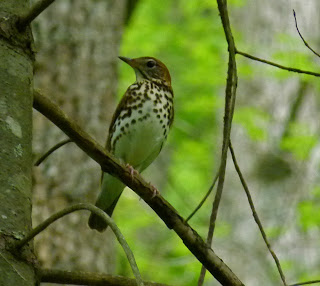and showy orchis within 3-4 feet of the pathway.
The pink Lady's slipper was much more elusive though, and we risked tripping on roots and rocks in the path to scan both sides of the hill for them.
Typically, I envision orchids as large and elaborate, the big flower you wear at the prom. But many orchids are small and inconspicuous, if not downright invisible! This spring coralroot is an orchid, and the closer I stood to get a photo of the minute blossoms, the harder it was to focus.
The birds sang all day, from Carolina Wrens who sounded like they were using amplifiers, to three little Ruby-throated Hummingbirds dive bombing each other at the feeder. I often thought the same Hooded Warbler was following us around, since we heard one no matter where we hiked, along with many other unseen warblers. If I hadn't studied bird song for many years, I could only have claimed 5 or 6 species actually seen. But then a larger bird flew through the trees and sat where I could find it in the binoculars. The most wonderful Wood Thrush just sat and posed for at least 5 minutes! All his relatives or rivals had serenaded us, but this one came out to take a bow!
He showed each profile, then turned so we could see his warm cinnamon brown back and pink legs. This bird certainly made up for all my disappointment with the other birds that stayed in hiding!
Each of the Kentucky State Parks has a dining room with a view, and they hang bird feeders by the windows for the entertainment of the diners. As always, the gray squirrels show off their acrobatics chasing each other up and down the trees, jumping on the feeders, and hogging all the seed. We met a couple who have attended 30 of these wildflower weekends at Natural Bridge and they gave us a tip. "Come back this evening, when the dining room is closed and darkened," they said. "The flying squirrels come then to get their share of the sunflower seeds." We gingerly shined a flashlight to be sure they were present, and the small noctural squirrels weren't disturbed at all. I got brave and turned on my camera flash, and that didn't bother them either, so I got some marvelous photos of their shining eyes and sleek skin folds they use to fly! Every few minutes, you would see a faint glimpse of something in the air - another flying squirrel. I've never seen them in the wild before, so it was truly exciting, and I passed the tip along to a little girl in the lobby the next day. Hope she was able to see some.























